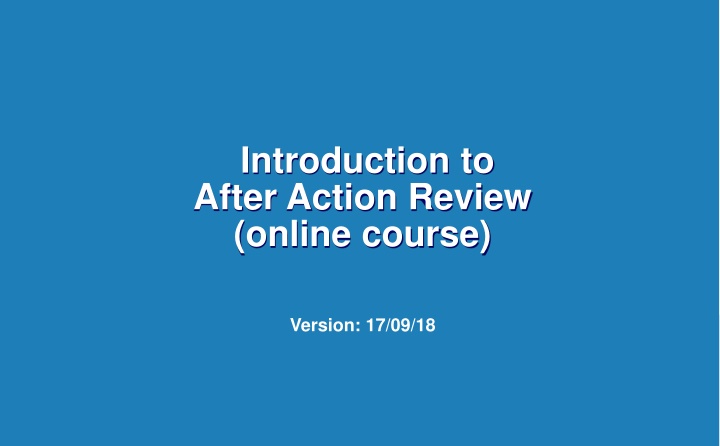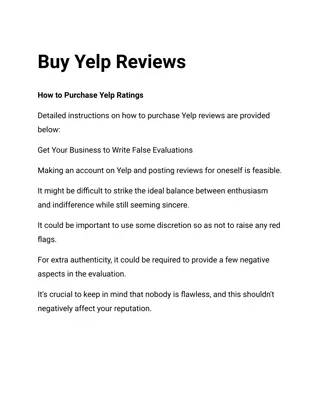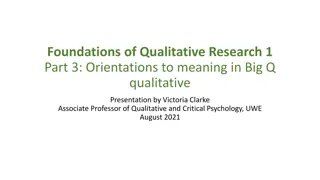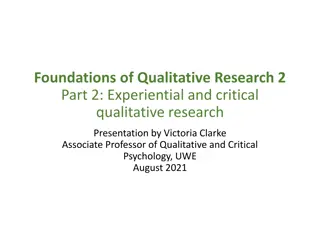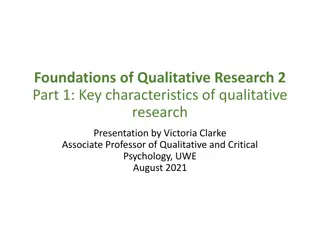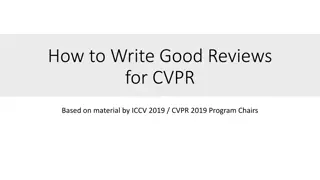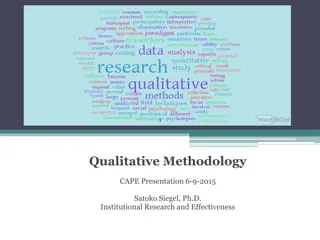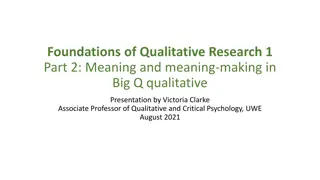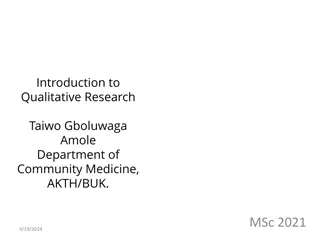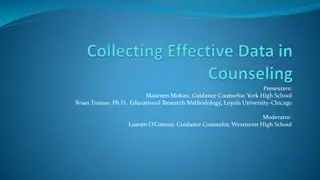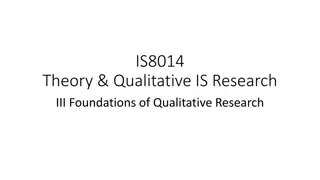Qualitative Review of After Action Reviews
An After Action Review (AAR) is a qualitative review process that analyzes responses to emergencies, identifying practices, gaps, and lessons learned. This course covers the principles, group processes, facilitation techniques, and key success factors for AARs. Understand how AARs contribute to collective learning and capacity assessments within the IHR Monitoring & Evaluation Framework.
Download Presentation

Please find below an Image/Link to download the presentation.
The content on the website is provided AS IS for your information and personal use only. It may not be sold, licensed, or shared on other websites without obtaining consent from the author.If you encounter any issues during the download, it is possible that the publisher has removed the file from their server.
You are allowed to download the files provided on this website for personal or commercial use, subject to the condition that they are used lawfully. All files are the property of their respective owners.
The content on the website is provided AS IS for your information and personal use only. It may not be sold, licensed, or shared on other websites without obtaining consent from the author.
E N D
Presentation Transcript
Introduction to After Action Review (online course) Version: 17/09/18
Learning Objectives E- Learning Course 45 minutes Introduction to After Action Reviews At the end of this module, you will be able to: Understand the principles of After Action Reviews Explain the working group After Action Review (AAR) process Understand the role of facilitators and note takers in the process and describe participatory facilitation techniques Recognize the key factors for a successful working group AAR
Should I take this e- learning course? When should I take this this e- learning?
Course Content 1. Description and purpose of After Action Reviews 2. Key steps of After Action Reviews 3. Facilitator preparation and guidance
What is an After Action Review? An After Action Review (AAR) is a qualitative review of actions taken to respond to an emergency as a way of identifying best practices, the gaps and lessons learned It is a space for collective learning by bringing together the relevant individuals to critically and systematically analyse actions taken during the response
How does it fit within the IHR Monitoring & Evaluation Framework? Assessments conducted by MoH or jointly with WHO under the IHR monitoring and evaluation framework (IHRMEF) Joint External Evaluation: Desk review conducted by external experts of 19 technical areas using the JEE tool JEE Annual Reporting: National self- evaluation of capacities submitted on a yearly basis covering 13 technical areas (2017) After Action Review: Qualitative review of actions taken to respond to a real emergency for the purposing of learning and assessing the functionality of capacity Real country capacity AR AAR Simulation exercises to develop, assess and test emergency systems, procedures and mechanisms to respond to outbreak and public health emergencies. Simex
AAR as part of preparedness and response cycle Annual reporting Identification of gaps and best practices IHR National Action Plan After Action Review JEE (every 5 years) IHR capacity building in the emergency response cycle Simulation Exercise Organising systems and building capacity Emergency response Training and equipping
LEARNING ATTRIBUTES OF AAR Learning on individual level role within the management of an emergency Personal learning Learning within a team, for better team dynamics and understanding within emergency management process Improvement to overall emergency management, such as through improved preparedness and response plans, mechanisms of coordination, etc Collective learning Institutional learning
Why do an After Action Review? Document, Record & Share Assess Identify functional capacity of practical, lessons learned with other public health professionals actionable steps for improving preparedness & response systems existing systems to prevent, detect and respond to Public Health Event Contribute Achieve to transparency and mutual accountability collective vision amongst response stakeholders of how to do better in the future
Key actions carried out during AARs Objective observation Analysis of gaps and best practises and contributing factors Identify the gap between planning and practice. Analyse what worked well and what worked less well and why. Establish how actions were actually implemented during the response, in contrast to how they are supposed to or normally happen, according to plans and procedures. Identify areas of improvement Identify actions to strengthen or improve performance and how to follow up
What are the key principles of an after action review It is participative participants are encouraged to engage in an active and respectful manner Open and honest feedback is given There is space for experience sharing and mutual learning There is analysis of systems and processes and not an evaluation of individuals The intent is to identify solutions and compile a list of key activities/recommendations to improve future responses
4 formats of an AAR proposed by WHO Key informant interview Debrief Working group Mixed method Factors affecting the format selection include location and number of participants, cultural context, health event complexity and resources required. More info in the AAR Guide (link)
How should AARs be organized? Key informant interview Mixed method Working group Debrief Debrief (Narrow scope): Deeper analysis of the technical area and maximize learning Small group discussion Informal focus on a specific technical area involve onlyindividuals and partners that were involved in this area should not take more than half a day max.
How should AARs be organized? Key informant interview Mixed method Working group Debrief Working group AAR (medium scope): highlight synergies between areas & stakeholders of a response Larger, more diverse, group of participants cover multiple technical areas of a response in parallel Done through structured working group discussion usually takes 3 days
How should AARs be organized? Key informant interview Mixed method Working group Debrief Key informant interview: Allow to express ideas & opinions more freely than in group formats one-to-one interviews with key stakeholders Appropriate where responders are no longer in the same place or if complexity of the event requires it. But do not benefit from the value of collective analysis Less ownership over results
How should AARs be organized? Key informant interview Mixed method Working group Debrief Mixed method (comprehensive review): in-depth analysis including the decision- making and strategic levels Suitable for full-scale AARs involving a larger number of participants and stakeholders This can be a combination key informant interviews, and debrief or working group AAR formats This can be resource and time intense This requires an AAR team to consolidate and document results
Toolkit for the 4 methods Key informant interview Mixed method Working group Debrief Examples of Tools: The AAR Toolkit contains guidance and tools for all 4 methods Templates of concept notes, agendas, note takers forms, reports, evaluations etc. Planning checklist and template budgets Facilitator guidance manuals and supporting PPT presentations More details about the 4 AAR formats can be found at this links: AAR guide (link) AAR toolkits (link)
Introduction to working group format AAR This e-learning focuses on the facilitation of working group AAR format AAR, for being the most implemented AAR so far. This AAR format: involves the analysis of multiple functions of a response such as surveillance, coordination or communications (these will be determined prior to the AAR) brings together 20-50 participants of the relevant stakeholders in the response takes 2.5 to 3 days is used in instances where those involved in a response can be brought together to share learning and experiences in an open and honest environment.
Stages of the After Action Review process This section of the e-learning describes the steps of a group work After Action Review. The 5 sessions follow a structured methodology with user-friendly material, group exercises and interactive facilitation techniques. Session 1 What was in place before the response? Session 2 What happened during the response? Session 3 What went well? What went less well? Why? Session 4 What can we do to improve for next time? Session 5 The way forward
Session 1 What was in place before the response? Objective : to establish what was in place prior to the response that should have been used to support the response
Session 2 What happened during the response? Objective: To discuss and agree upon the key events of the response and build a comprehensive timeline
Session 2 What happened during the response? Example of timeline of key events during the Pulmonic Plague in Madagascar in 2017 (AAR conducted in july 2018)
Session 3 What went well? What went less well? Why? Objective: To identify the key challenges and best practices encountered during the response, their impacts on the response, and the factors that lead to them Best Practice Impact(s) Enabling factors Regular cross border coordination meetings Improved coordination and sharing of information for the early detection of suspected / confirmed cases and for monitoring contacts Relationship had been established prior to the response Willingness of all stakeholders to undertake regular meetings Political and financial support from central level Challenges Impact(s) Limiting Factors Coordination at local level ineffective Response not coordinated between partners, health authorities and the central level Duplication of activities and effort Inefficient use of resources Lack of a plan for district level coordination Partners not participating coordination meetings
Session 3 What went well? What went less well? Why? Example: Nigeria Lassa Fever response AAR (2018) Best Practice Impact(s) Enabling factors Development of National algorithm for Lassa Fever Improved quality of test results Standardization of laboratory procedures Existing collaboration with laboratory stakeholders led by the Nigeria Centre for Disease Control (NCDC) and WHO Collaboration between State, NGOs and partners to reach a larger community on Lassa Fever Awareness and sensitization Increased coverage and awareness Improved positive behavioural change Prior established relationship between state health educators and NGOs/partners Involvement of NGOs and partners in planning and implementation Regular meetings with NGOs and partners
Session 3 What went well? What went less well? Why? Example: Nigeria Lassa Fever response AAR (2018) Challenges Impact(s) Limiting factors Stockout of consumables and supplies for LF case management e.g. Ribavirin, Hand gloves in all treatment centres Delay in commencing treatment for patients Increase in mortality Exposure of HCWs Number of patients seen in the outbreak greater than expected Paucity of manpower in treatment centres Poor human resource for health planning Available HCWs overwhelmed with high patients workload Increased risk of exposure of HCWs
Session 4 What can we do to improve for next time? Objective: To identify the key activities that can be undertaken in order to overcome challenges and embed best practice for future responses.
Session 5 The way forward Objective: To clarify the way forward for activities defined through the workshop and define the final steps in the AAR process
What are the key steps for facilitators in the group AAR process? E-learning completed Read Facilitator guidance document Attend Pre AAR meeting Co-facilitate Action Review Exercise Follow up on key activites post AAR
Tick/click on?? those things that apply to an after action review: 1. It requires participants to be open and honest in their feedback 2. It involves an external evaluation of the response 3. It is a place for sharing and learning from individuals experiences 4. It is a chance to identify what went well and what could be improved 5. It is a chance to identify individuals who did not perform well
Rules of Participation The below is the guidance given to participants. As a facilitator you are asked to ensure: Working sessions start and end on time Different points of view are respected Writing is legible and clear Participant stay engaged Participants do not use laptops, mobile phones Groups used the colored cards/post its assigned to them throughout the workshop
Question Take 1 minute to identify 3 attributes of a good AAR facilitator Attributes could include: Encouraging and inclusive Non judgmental Allows the group to speak Neutral - doesn t allow their opinion to influence the group Helps the group to stay focused on the task
Facilitator Tips Maintain an unbiased perspective and use open-ended questions to guide the discussion. Focus on learning. AAR is not an evaluation of performance but an opportunity to learn challenges and best practices. Encourage people to give honest opinions. Encourage active participation by all participants, including silent participants. Encourage groups to write legibly on cards, post-its, and flipcharts.
What to avoid as a facilitator Criticize, blame or judging the feedback Focusing on the negative. An AAR is as much about recording and analyzing what worked well as about what did not work. While the AAR is a learning framework, the teaching of participants should be avoided. Do not allow your own opinion or experience to influence or disrupt the conversation of groups
Root Cause Analysis Consequences A method to identify causal factors that lead to successes or challenges in relation to identified problems. It should be used when a problem is identified that clearly requires deeper examination or for which the why this problem occurred is not answered. Problems 5 Whys method is the simplest and most frequently used. In essence, the facilitator repeatedly asks why in order to progressively unpack causative factors in order get to the root cause of a particular issue. Causes Listen to the conversation below.
Case study You are working with a group who has several dominant participants. You notice that several people have not contributed to the discussion. They appear to have become disengaged from the process and are no longer trying to contribute. Take a minute to think about what you might do in this situation to help ensure everyone is able to have their say? They can then click on an arrow/button that leads to this text: Ideas to encourage participation in this context could include breaking the group into smaller groups to allow more active participation. Allow them time to work together before feeding into the group. asking people to discuss with their neighbor their ideas before asking each pair to share Do an individual reflection session and get participants to write their ideas on post it notes and then invite them to come and bunch them all on the flip chart
Tips for note takers Transcribe everything written on the cards, flip charts, sticky notes during Sessions 1, 3, 4 and 5 in the provided templates. Use the template from the lead facilitator for taking notes. This is in the same format as the sessions to enable you to record everything that is written. When additional information is discussed but not written by the group, be sure to save it for discussion during subsequent sessions.
Click on the below steps in the AAR process in the correct order What went well? What went less well? Why? (number 3) The way forward (number 5) What happened during the response? (number 2) What can we do to improve for next time? (number 4) What was in place before the response? (this is number 1)
Thank you for your time and commitment to the AAR process
